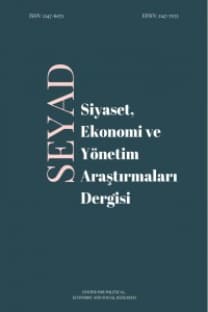Asimetrik Döviz Kuru Geçişkenliği: Türkiye Örneği
Döviz Kuru Geçişkenliği, Asimetri, Vektör Hata Düzeltme
Asymmetric Exchange Rate Pass-Through: The Case of Turkey
Exchange Rate Pass-Through, Asymmetry, Vector Error Correction,
___
- Al-Abri, A. S., Goodwin, B. K., (2009). “Re-examining the exchange rate pass-through into import prices using nonlinear estimation techniques: threshold cointegration”, International Review of Economics and Finance, 18, pp. 142–61.
- Aron, J., Farrell, G., Muellbauer, J., Sinclair, P., (2014). “Exchange Rate Pass-through to Import Prices, and Monetary Policy in South Africa”, The Journal of Development Studies, 50:1, pp. 144-164.
- Azgün, S . (2013). “Türkiye’de Döviz Kuru Hareketlerinin İç Fiyatlara (İthalat Fiyatları, ÜFE ve TÜFE) Geçişi”, Sosyoekonomi, 20 (20), ss.93-106.
- Bacchetta, P., van Wincoop, E., (2005). “A Theory of the Currency Denomination Of International Trade”, Journal of International Economics, 67 (2), pp. 295-319
- Bayat, T., Özcan, B., Taş, Ş., (2015), “Türkiye’de Döviz Kuru Geçiş Etkisinin Asimetrik Nedensellik Testleri ile Analizi”, Eskişehir Osmangazi Üniversitesi İktisadi ve İdari Bilimler Fakültesi Dergisi, Cilt 10, Sayı 2, ss. 7-30.
- Beckmann, J., Belke, A., Verheyen, F., (2013). “Interest Rate Pass-Through in the EMU - New Evidence from Nonlinear Cointegration Techniques for Fully Harmonized Data”, Journal of International Money and Finance, Vol. 37, pp. 1-24 (frühere Versionen erhältlich als DIW Discusion Paper 1223, Ruhr Economic Paper 350).
- Betts, C., Devereux, M.B., (1996). “The exchange rate in a model of pricing-to-market”, European Economic Review, 40, pp. 1007–1021.
- Betts, C., Devereux, M. B., (2000). “Exchange-rate dynamics in a model of pricing-to market”, Journal of International Economics, 50, pp. 215-244.
- Brun-Aguerre, R., Fuertes, A., Phylaktis, K., (2012). “Exchange rate pass-through into import prices revisited: What drives it?”, Journal of International Money and Finance, 31, Issue 4, pp. 818-844.
- Bussière, M., (2007). “Exchange rate pass-through to trade prices –the role of non-linearities and asymmetries”, ECB Working Paper No. 822, European Central Bank, Frankfurt am Main.
- Caballero, R. J., Engel, E M R A (1993). “Microeconomic rigidities and aggregate price Dynamics”, European Economic Review, Vol. 37, pp. 697-717.
- Campa, J., Goldberg, L. S., (2002). “Exchange Rate Pass Through into Import Prices: A macro or micro http://www.nber.org/papers/w8934 National Bureau of Economic Research (NBER)
- Campa, J., Goldberg, L. S., (2005). “Exchange Rate Pass Through into Import Prices.” Review of Economics and Statistics 87, 4 (November), pp. 679-690.
- Campa, J., Goldberg, L. S., (2008). “Pass-Through of Exchange Rates to Consumption Prices: What Has Changed and Why?,” NBER Chapters, in: International Financial Issues in the Pacific Rim: Global Imbalances, Financial Liberalization, and Exchange Rate Policy (NBER-EASE Volume 17), pp. 139-176 National Bureau of Economic Research, Inc.
- Çiçek, S., Boz, Ç., (2013). “A New Test of Exchange Rate Pass-through in a Small Open Economy: Evidence from Asymmetric ARDL Bounds Approach”, İktisat, İşletme ve Finans 333 (Aralık), pp. 43-64.
- Delatte, A., López-Villavicencio, A., (2012). “Asymmetric exchange rate pass-through: Evidence from major countries,” Journal of Macroeconomics, Elsevier, vol. 34(3), pp. 833-844.
- Dedeoğlu, D., Kaya, H., (2015). “Model Belirsizliği Altında Döviz Kurunun Enflasyona Etkisi,” of Turkey, vol. 15(2), pp. 79-93.
- Ehsan U. C., Hakura, S. D. (2015). “The exchange rate pass-through to import and export prices: The role of nominal rigidities and currency choice”, Journal of International Money and Finance, Volume 51, March 2015, pp. 1-25.
- Ergin, A. (2015). “Döviz Kuru ve Enflasyon Arasındaki Geçiş Etkisi: Türkiye Örneği”, Niğde Üniversitesi İktisadi ve İdari Bilimler Fakültesi Dergisi, 8(3), ss. 13-29.
- Hahn, E. (2003). “Pass-through of external shocks to euro area inflation”, ECB Working Paper, No. 243, European Central Bank.
- Herzberg, V., Kapetanios, G., Price, S., (2003). “Import prices and exchange rate pass-through: theory and evidence from the United Kingdom” Bank of England Working Paper no. 182.
- Kara, H., Öğünç, F., (2012). “Döviz kuru ve ithalat fiyatlarının yurt içi fiyatlara etkisi,” İktisat İşletme ve Finans, Bilgesel Yayıncılık, vol. 27 (317), pp. 9-28.
- Krugman, P. R., (1987). “Is Free Trade Passe?” Journal of Economic Perspectives, 1(2), pp. 131-144.
- McCarthy, J., (2000). “Pass-through of exchange rates and import prices to domestic inflation in some industrialized economies”, Federal Reserve Bank of New York Staff Report, Number 111.
- Mumtaz, H., Sunder-Plassmann, L., (2010). “Time-varying dynamics of the real exchange rate. A structural VAR analysis”, Bank of England working papers 382.
- Özkan, İ., Erden, L. (2015). “Time-varying nature and macroeconomic determinants of exchange rate pass-through”, International Review of Economics & Finance, Volume 38, July, pp. 56-66.
- Nguyen, T. A., Kiyotaka, S., (2015). “Asymmetric Exchange Rate Pass-Through in Japanese Exports: Application of the Threshold Vector Autoregressive Model”, Discussion papers 15098, Research Institute of Economy, Trade and Industry (RIETI).
- Peltzman, S., (2000), “Prices Rise Faster than They Fall” Journal of Political Economy 108(3), pp. 466- 502.
- Pollard, P., Coughlin, C., (2004). “Size matters: asymmetric exchange rate pass-through at the industry level”, No 2003-029, Working Papers, Federal Reserve Bank of St. Louis, http://EconPapers.repec.org/RePEc:fip:fedlwp:2003-029.
- Przystupa, J., Wrobel, E. “Asymmetry of the Exchange Rate Pass-Through”, Eastern European Economics” 49:1, pp. 30-51.
- Sekine, T.i (2006). “Time-varying exchange rate pass-through: experiences of some industrial countries”, Bank for International Settlements, Working Paper, 202.
- Taylor, J. B., (2000). “Using monetary policy rules in emerging market economies”, The 75th Anniversary Conference, “Stabilization and Monetary Policy: The International Experience”, Bank of Mexico.
- Yanamandra, V., (2015). “Exchange rate changes and inflation in India: What is the extent of exchange rate pass-through to imports?”, Economic Analysis and Policy, 47, pp. 57-68.
- ISSN: 2147-6071
- Yayın Aralığı: Yılda 2 Sayı
- Başlangıç: 2014
- Yayıncı: Politik Ekonomik ve Sosyal Araştırmalar Merkezi
Türkiye’de Sosyal Belediyecilik Uygulamalari Üzerine Bir Değerlendirme
Mustafa KOCAOĞLU, Cazibe AYDOĞAN, Özge Karabulut AKKUŞ
Türkiye’de Kişisel Verilerin Korunması Politikasının Analizi
Kalkınma İşbirliğinde Etkinlik Arayışları ve Yeni Aktörler: Paradigma Dönüşümü
Konut Konulu Makalelerin Sosyo-Politik Nitel Analizi 2005-2015 Dönüşümü
Yılmaz ÖZKAN, Abdulkadir ALTINSOY, Ufuk BİNGÖL
İlkay Sevinç TURAÇ, Gamze Bayın DONAR
Avrupa Birliği Politikalarında Üye Devletlere Tanınan İstisnaların Tarihsel ve Politik Arka Planı
Doğu’da Yönetimin Esasları: Nizamü’l Mülk’ün Siyasetnamesi Üzerine Bir Değerlendirme
